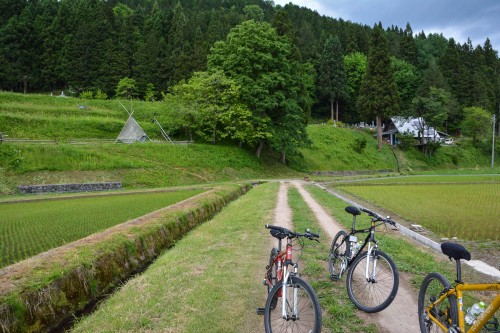The journey for a glimpse of Jomon Sugi is a long and arduous 9 hours hike through mossy forest, questionably wonky bridges and unknown random pathways. It’s incredibly easy to lose your path if, like me, you lack a proper map that isn’t just the typical Japanese squiggly lines. Luckily, the route is incredibly popular with Japanese people and tourists alike, so I could easily follow someone through this Japanese-only sign posted, no ribbon marked mind field. Better still, get your phrase book out and ask someone. You might get lucky and, like me, end up tagging along with someone who actually speaks pretty good English.
Jomon Sugi is located on Miyanoura-dake which, at 1,300m, is the highest peak on Yakushima. And, at 25.3m tall, with a trunk circumference of 16.4m, it is the largest and oldest yakusugi on the island, and the largest conifer in the whole of Japan. It’s actual age is unknown, but it has been estimated between 2,170 and 7,200 years old, with most people agreeing that it is probably over 5,000 years old. The tree itself was discovered in 1968 and immediately sparked some movements towards increasing tourism to the island, as well as to protecting the trees and the surrounding environment.
Reaching the tree’s observation deck, built following the designation of Yakushima as a World Heritage Site in 1933, takes a good 4 to 5 hour hike and, with the last bus leaving Arakawa Trail Entrance at 16:53pm, it means you’ll need to set out pretty early to get there and back in time. In fact, I was up and at the bus stop from Miyanoura port at the ridiculously ripe time of 4:09.
If you’re leaving from Miyanoura port, you will need to change to the mountain climbing bus at Yakusugi Shizenkan (museum). Please be warned however, that even though it is ridiculously early, there will be a good amount of people wanting to take this bus, so you may need to wait a while. Luckily, I was alone so it was easy for me to jump the queue, but if there are a few of you, you will be harder to seat, so bare this in mind. I would recommend taking the earliest bus possible from your accommodation.
This hike is extremely long and only increases with intensity as you depart from the beautifully mossy train tracks and begin to climb into the clutches of the weaving, clawing, twisted trees and roots of the forest. Please be warned that this hike requires a good level of fitness and stamina. Come prepared and be aware of what you are capable of.
Here’s a few essential items that you will want to take with you:
- Water. Bring a small water bottle you can refill whenever you see a pipe with flowing water or even a waterfall. Do not dehydrate!
- Food. This is a very long hike. You will want to bring some lunch you can eat at a resting stop near Jumon Sugi (you cannot eat on the observation deck). You will also need to bring snacks and, with a lack of proper resting stops that can fit more than a few people, it is worth investing in snacks that will be easy to consume on the go. For example, an energy bar, cereal bar or some gel packs.
- Hiking boots. An absolute necessity.
- Light wet weather gear. Since you will be climbing and probably getting exceedingly hot, a light waterproof jacket with a hood will be your best bet for the occasional raining spurts of Yakushima.
- Layers. Try to layer some easily removable clothing, since you will probably get hot on the way up and cool down a bit on the way back. Trust me, you will probably be more hot than cold if you’re determined to make it to Jumon Sugi.
- Wet wipes. To me, wet wipes are an essential part of almost any journey, particularly those into the mountains. They’re good for any kind of sanitary need and come in handy for a ridiculously large amount of things. In fact, I used almost an entire pack in just my short visit to Yakushima.
- A plastic bag. My mother always used to send me off on school trips with a plastic bag in my rucksack and I never fully appreciated why until I found one in my old bag one day and finally used it to sit down on when the bench was wet. A large plastic bag is perfect for sitting on, putting wet items in or using as a rubbish bin.
- A rucksack with waist straps. This tip actually came from my little sister, and i’m ridiculously glad she told me before I went on the longest hike of my life. This is really a must have item as no matter how light you may think your bag is, you will no doubt think differently 5 hours in. Really, the more straps you can get across your chest the better as it distributes the weight away from your shoulders and back, and saves you a fair amount of pain in the long run.
The trail I followed goes right past Wilson Stump which, if I’m honest was more of a reason for my hike than Jumon Sugi was. In fact, I only went to see Jumon Sugi because I thought it was ‘close by’, which in reality it really isn’t, but you might as well see both if you’ve come that far.
Wilson stump is a large, hollow tree trunk that you can enter. The cavity of the old tree contains a small shrine but the real magic happens when you look up. Peering through the top, at the correct angle, which may involve some significant corner crouching, and you can see that the opening creates the shape of a heart. Having seen some impressive images online, I was expecting something with a little more gravitas than the awkward time I spent in a puddle in the corner of the stump, trying to get an impressive picture of a well-shaped heart. I was glad I saw it but Jumon Sugi, and the entire journey along the mossy, surreal train tracks were the real highlight. In the end.
This being said, Jumon Sugi was definitely a sight to behold, even through the misty, raining weather. It was by far and without any doubt the biggest tree i’ve seen in my life, and the temptation to want to measure myself against it was vast, but of course, I had to settle for the observation deck. It’s trunk bulged with muscularity, while the morning sun broke through the leaves in patches around it, beaming an almost holy-looking light to its roots. There was definitely some kind of supernatural strength and power surrounding the tree, almost as if it could both heal and destroy at the same time. Jomon Sugi truly is the protector of the forest, sheltering the smaller trees, its animals and its nature with in its strong branches.
Only upon returning and researching this tree did I realise the gravity of what i just witnessed. There was no doubt that I knew it was something special when I saw it but it is difficult to fathom a tree that old. Imagining its growth over the years and what it must have witnessed is baffling. Its magnitude and age makes you realise just how small you are in the grand scheme of life.
So, take this almost spiritual journey to see the real essence of the forest and conquer the hike.
[cft format=0]






















No Comments yet!